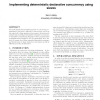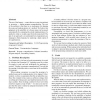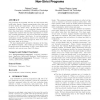6740 search results - page 55 / 1348 » Using Classification as a Programming Language |
181
click to vote
POPL
2007
ACM
16 years 9 hour ago
2007
ACM
The predominant thread-based approach to concurrent programming is bug-prone, difficult to reason about, and does not scale well to large numbers of processors. Sieves provide a s...
69
Voted
OOPSLA
2007
Springer
15 years 5 months ago
2007
Springer
The use of bad names — names that are wrong, inconsistent or inconcise — hinder program comprehension. The root of the problem is that there is no mechanism for aligning the n...
ICFP
2003
ACM
15 years 11 months ago
2003
ACM
Lazy programs are beautiful, but they are slow because they build many thunks. Simple measurements show that most of these thunks are unnecessary: they are in fact always evaluate...
135
click to vote
ECOOP
2012
Springer
13 years 2 months ago
2012
Springer
R is a dynamic language for statistical computing that combines lazy functional features and object-oriented programming. This rather unlikely linguistic cocktail would probably ne...
SCAM
2008
IEEE
15 years 6 months ago
2008
IEEE
An appropriate translation of the data model is central to any language migration effort. Finding a mapping between original and target data models may be challenging for legacy l...



